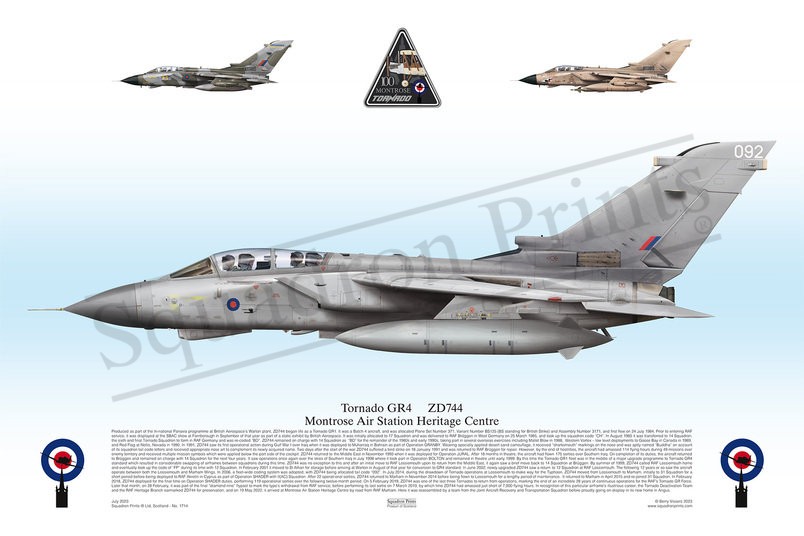#1714 Montrose Tornado GR4 print

Description
Squadron Prints Lithograph No. 1714 - ZD744 '092', Tornado GR4, Montrose Air Station Heritage Centre.
Produced as part of the tri-national Panavia programme at British Aerospace’s Warton plant, ZD744 began life as a Tornado GR1. It was a Batch 4 aircraft, and was allocated Plane Set Number 371, Variant Number BS125 (BS standing for British Strike) and Assembly Number 3171, and first flew on 24 July 1984. Prior to entering RAF service, it was displayed at the SBAC show at Farnborough in September of that year as part of a static exhibit by British Aerospace. It was initially allocated to 17 Squadron and was delivered to RAF Brüggen in West Germany on 25 March 1985, and took up the squadron code “CH”. In August 1985 it was transferred to 14 Squadron, the sixth and final Tornado Squadron to form in RAF Germany and was re-coded “BD”. ZD744 remained on charge with 14 Squadron as “BD” for the remainder of the 1980s and early 1990s, taking part in several overseas exercises including Mallet Blow in 1988, Western Vortex – low level deployments to Goose Bay in Canada in 1989, and Red Flag at Nellis, Nevada in 1990. In 1991, ZD744 saw its first operational action during Gulf War I over Iraq when it was deployed to Muharraq in Bahrain as part of Operation GRANBY. Wearing specially applied desert sand camouflage, it received “sharksmouth” markings on the nose and was aptly named “Buddha” on account of its squadron tail code letters and received appropriate nose art to complement its newly acquired name. Two days after the start of the war ZD744 suffered a bird strike on 18 January 1991 and was returned to RAF Brüggen for repair. However, by the end of hostilities, the aircraft had amassed 114 flying hours during 49 missions over enemy territory and received multiple mission symbols which were applied below the port side of the cockpit. ZD744 returned to the Middle East in November 1993 when it was deployed for Operation JURAL. After 18 months in theatre, the aircraft had flown 175 sorties over Southern Iraq. On completion of its duties, the aircraft returned to Brüggen and remained on charge with 14 Squadron for the next four years. It saw operations once again over the skies of Southern Iraq in July 1998 where it took part in Operation BOLTON and remained in theatre until early 1999. By this time the Tornado GR1 fleet was in the middle of a major upgrade programme to Tornado GR4 standard which resulted in considerable swapping of airframes between squadrons during this time. ZD744 was no exception to this and after an initial move to RAF Lossiemouth upon its return from the Middle East, it again saw a brief move back to 14 Squadron at Brüggen. By summer of 1999, ZD744 called RAF Lossiemouth home and eventually took up the code of “FP” during its time with 12 Squadron. In February 2001 it moved to St Athan for storage before arriving at Warton in August of that year for conversion to GR4 standard. In June 2002, newly upgraded ZD744 saw a return to 12 Squadron at RAF Lossiemouth. The following 12 years or so saw the aircraft operate between both the Lossiemouth and Marham Wings. In 2006, a fleet-wide coding system was adopted, with ZD744 being allocated tail code “092”. In July 2014, during the drawdown of Tornado operations at Lossiemouth to make way for the Typhoon, ZD744 moved from Lossiemouth to Marham, initially to 31 Squadron for a short period before being deployed to RAF Akrotiri in Cyprus as part of Operation SHADER with II(AC) Squadron. After 22 operational sorties, ZD744 returned to Marham in November 2014 before being flown to Lossiemouth for a lengthy period of maintenance. It returned to Marham in April 2015 and re-joined 31 Squadron. In February 2018, ZD744 deployed for the final time on Operation SHADER duties, performing 119 operational sorties over the following twelve-month period. On 5 February 2019, ZD744 was one of the last three Tornados to return from operations, marking the end of an incredible 28 years of continuous operations for the RAF’s Tornado GR Force. Later that month, on 28 February, it was part of the final “diamond nine” flypast to mark the type’s withdrawal from RAF service, before performing its last sortie on 7 March 2019, by which time ZD744 had amassed just short of 7,000 flying hours. In recognition of this particular airframe’s illustrious career, the Tornado Deactivation Team and the RAF Heritage Branch earmarked ZD744 for preservation, and on 19 May 2022, it arrived at Montrose Air Station Heritage Centre by road from RAF Marham. Here it was reassembled by a team from the Joint Aircraft Recovery and Transportation Squadron before proudly going on display in its new home in Angus.
